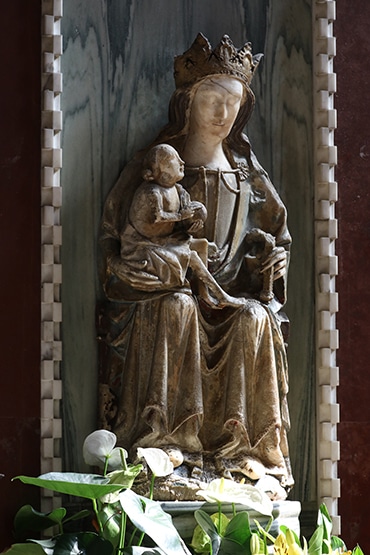
Treasures
As a new building, Westminster Cathedral had no legacy of art or treasure to inherit. The historic and beautiful items which the Cathedral treasures today are mainly gifts or commissions. These are not museum pieces. The beautiful vestments and Church vessels continue to be used, as they should be used, in the celebration of Mass.
Our Lady of Westminster
Beneath the thirteenth Station of the Cross is a 15th-century statue of Our Lady and the Christ child, acquired for the Cathedral in 1955 and installed as Our Lady of Westminster. She is carved in English alabaster, likely from Chellaston near Nottingham which in the 14th and 15th centuries was a major production centre for religious statues that were especially popular on the continent. The statue depicts Our Lady seated on a throne as the Queen of Heaven with a lily sceptre in her left hand; her right arm supports the Christ child. Nottingham alabaster was traditionally brightly painted and flecks of paint remain: blue and red on the gown, and at Our Lady’s feet a green meadow strewn with daisies. The statue is flat backed, and partly bas relief. She may have been intended for a wooden altarpiece.
The statue was acquired by an ecclesiastical dealer in France in the 1950s and put up for sale at the Grosvenor Antiques Fair in London. The Dean of York had already placed a bid for York Minister and launched a public appeal to finance the acquisition. Undeterred, Westminster Cathedral’s Administrator Monsignor Gordon Wheeler said: ‘If the arrangement were to fall through, I would be very grateful if you would let me know.’
The Dean of York received just one donation, the sale fell through, and Our Lady of Westminster was bought for the Cathedral and dedicated on 8 December 1955, the Feast of the Immaculate Conception. Pre-Reformation there were two local shrines to Our Lady of Westminster: one at the Westminster Abbey, and one where the Houses of Parliament now stand. The Abbey’s Our Lady of the Pewe is based on the Westminster Cathedral statue.

The Altar Cross
Bentley wanted the high altar and baldacchino of the Cathedral to be the ‘crown of his work’ and the drawings he prepared for the sanctuary were his last. The beautiful altar cross of gilt bronze and enamel was designed after Bentley’s death by the firm he founded, Bentley, Son and Marshall. It was used for the first time at the Mass of Consecration in 1910.
The cross is 7ft 3in in height and 2ft 9in wide and matches the candlesticks on either side. It is very heavy. Pendants of pear-shaped crystal surround the central crucifix which is cast in bronze; the arms of the cross are decorated with diamond-shaped lozenges of red enamel.
The first and last letters of the Greek Alphabet, Alpha and Omega, hang from the arms of the cross to symbolise the words from Revelation 22:13: ‘I am the Alpha and the Omega; the first and the last, the beginning and the end.’
The cross is best seen in the morning, especially in spring and autumn, when the rising sun streams through the east windows of the apse illuminating the crystal surround and creating a halo effect.









